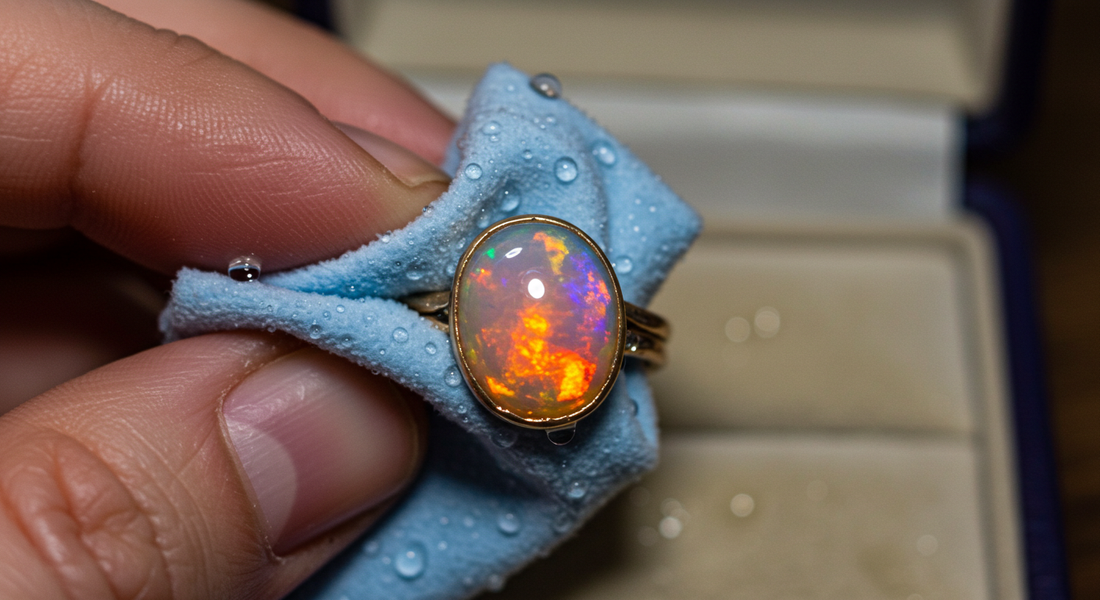Many wonder whether opal, a gemstone renowned for its captivating "play-of-colour," is durable enough to wear daily and if it is appropriate for formal or informal occasions. Fans and potential purchasers must be aware of its hardness and maintenance needs in addition to its indisputable eye-catching visual qualities. Learn everything about opal's hardness, how it compares to other gemstones, common misconceptions busted, and how to take care of it so it stays beautiful for years to come with this in-depth guide.
Understanding Opal Hardness

A qualitative scale that evaluates the scratch resistance of minerals, the Mohs scale is used to determine the hardness of opals. Opal is in the same hardness group as glass, with a typical range of 5.5 to 6.5 on this scale. Opals are softer than harder gemstones such as diamonds, sapphires, or quartz, making them more prone to scratches and cracks, yet they can still endure little bumps.
One of the main factors that determines how hard an opal is is its unique composition and structure. Opals typically have a water content of 6% to 10% in gem-grade opals; however, it may vary from 3% to 21% by weight. Opals are hydrated amorphous silica, having the chemical formula SiO₂·nH₂O. Because of its high water content, it is rather delicate. Opals' mesmerising colour play is caused by tiny silica spheres organised in a grid-like pattern that scatters light. This structure not only determines the gem's hardness and impact resistance, but it also gives the opal its distinctive appearance. For more on opal's properties, visit the Gemological Institute of America (GIA) opal guide.
Discover our exquisite opal jewelry collection at Cove Jewellery, Sydney's premier store for Australian opals.
Gemstone Hardness
On the Mohs scale, which goes from 1 (talc) to 10 (diamond), the hardness of gemstones is normally calculated. Opal is a gemstone with a hardness grade in the middle of the spectrum, falling anywhere between 5.5 and 6.5 on this scale. Opals are less resistant to scratches and other forms of damage than harder stones like sapphires and diamonds, though they are harder than softer stones like malachite (3.5-4) and comparable to turquoise (5-6). View a detailed Mohs hardness scale for gemstones.
If you're thinking about getting or caring for opal jewellery, you really must know how hard opal is. Although opal can endure everyday use, it does need a little more attention to preserve its lustre due to its mild hardness. For example, to keep opal items from getting scratches, it's best to store them gently and away from rough surfaces. To prevent damage, it is advised to store opal jewellery in a cushioned jewellery box or a delicate fabric bag. Opal's structure adds to its general fragility.
Hydrated Silica
Hydrated silica is the main ingredient of the gemstone, meaning that it incorporates water into its structure. Opal is very sensitive to variations in humidity and temperature because of its unusual composition, which also gives it its distinctive look. Extreme heat may cause dryness and cracking, so it's crucial to keep opal out of the sun for long periods of time.
One must proceed with care while cleaning the opal. Avoid using strong chemicals or ultrasonic cleaners on the stone because of its delicate nature. A delicate wash in lukewarm water with light soap would do the trick instead. To avoid damaging the surface, use a gentle brush to remove dirt and grime. Follow these opal care guidelines from GIA for best results.
What Determines How Long an Opal Lasts?
Opals are both durable and vulnerable to damage for reasons other than their intrinsic Mohs hardness:

Mineral Content and Structure
How hard an opal is depends on its water content, the size and arrangement of its silica spheres, and other factors. The hardness of a substance is defined as its resistance to breaking or chipping, while the scratch resistance is measured by the Mohs scale. The common description of opal's hardness is "very poor to fair," which means it is easily damaged by sharp objects.
Origin: Location
An opal's durability and unique qualities may be better understood by learning where it came from. The durability and vivid hues of opals from dry parts of Australia are well-known. Opals from Ethiopia, on the other hand, are less dense and more hydrophane, meaning they can soak up water; this is because they are often found in volcanic regions. If they absorb or lose water too quickly, their porous structure may cause changes in appearance and even fracture.
Type of Opal
The durability of opals may vary greatly across varieties. The inherent support of boulder opals, which remain linked to their ironstone or other natural rock matrix, makes them more durable. Once properly cured, solid opals - made wholly of precious opal—tend to retain their shape and clarity for quite some time. Explore our durable Australian Boulder Opal Pendant at Cove Jewellery, perfect for everyday wear with proper care.
The glue used to create doublets and triplets, composite stones composed of thin opal layers attached to a backing and sometimes capped with a transparent crystal, necessitates special handling for these stones.
Comparing Opal to Other Gemstones
If you want to know how hard opal is, it's best to look at it next to other popular gemstones. The hardest known mineral is diamond, which scores a perfect 10 on the Mohs scale. Its remarkable resistance to scratches and abrasion is a result of its hardness, which is several times more than that of opal.
Rubies and Sapphires (Corundum)
These stones have a Mohs hardness of 9. Because of their resilience and extreme hardness, they are attractive alternatives to opal for daily jewellery.
Quartz (e.g., Amethyst, Citrine)
In general, the Mohs hardness of quartz minerals is 7. Dust, which is prevalent and typically contains quartz, may thus damage opals.
Emerald
Emerald has a Mohs hardness of 7.5 to 8, making it harder than opal.
Turquoise
Turquoise ranges from 5 to 6 on the Mohs scale, similar to opal.
Amber and Pearl
The organic gems have Mohs hardness levels of around 2.5, making them much softer than opal.
Opals need extra caution while handling and caring for them because of their relative softness. When selecting opal jewelry, opt for quality pieces like those from Cove Jewellery to ensure longevity and beauty.
Wrapping Up
Opal is relatively durable, according to the Mohs scale, which rates its hardness between 5.5 and 6.5. Although it can endure regular use, it is important to take care of it properly so that its beautiful attributes remain. Opal enthusiasts may extend the enjoyment of this gem's exquisite beauty by avoiding harsh circumstances and utilising mild cleaning procedures.
Knowing how to properly care for and maintain an opal, whether you're wearing it as jewellery or giving it as a one-of-a-kind present, will ensure that it retains its beauty and lustre for many years to come. Visit Cove Jewellery in Sydney to find your perfect opal piece today.

